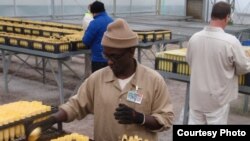With more than 2 million people behind bars, the United States has the largest incarcerated population in the world. But in a growing number of American prisons, inmates are doing more than just time — they are rearing endangered plants, animals and butterflies for release in the wild.
Past two metal detectors and multiple guard-posts topped with razor wire sits Washington State's Stafford Creek prison greenhouse complex, where a small crew in standard prison-issue khakis sows perennials. Months from now, these flowers will be transplanted to remnant lowland prairies near Tacoma and Olympia to provide food for endangered butterflies.
Toby Erhart and his fellow inmates have plenty of time to experiment, nurture and hone their craft on tray after tray of seedlings — a practice not economically feasible elsewhere.
"You cannot have a nursery that produces these for money because they would go broke, or the cost would be so high that nobody could ever restore anything," says the convicted child rapist, who says the greenhouse work has made him more observant and 'conscientious.' That's why this is such a good fit to have prisoners doing this... I mean, they don't have to pay us much."
That's the sort of outcome prison superintendent Pat Glebe likes to see.
"It helps with the level of violence in the prison because these inmates all of a sudden have something to do,” he says. “They see the value in it. And they see the value of giving back."
Glebe says many people have a preconceived notion of what prison looks like. Then they tour his facility and can't help saying "Wow!"
Success Stories
Washington’s prison environmental program was co-founded by The Evergreen State College and the state Department of Corrections in 2003.
Nurseries in the program have raised 64 different plant species for restoration of South Puget Sound prairies, according to Sustainability in Prisons Project program manager Kelli Bush. The Washington program has partnered with Northwest zoos and state and federal agencies to rear endangered animals as well.
"Since 2009, over 700 federally-threatened, state-endangered Oregon spotted frogs have been reared from eggs to adults at Cedar Creek Corrections Center," Bush wrote via email from Olympia. "Frogs are released into Pierce County wetlands each fall. To increase the sustainability of this project, crickets are raised as a supplemental food source."
The minimum security Mission Creek Corrections Center for Women raises the endangered Taylor’s checkerspot butterfly from larvae for release into the wild.
Stafford Creek’s conservation nursery has produced more than one million rare and endangered prairie plants since it opened five years ago.
Growing Idea
Inmates elsewhere in the United States are turning over new leaves, too.
At a state prison in Ohio, inmates are rearing endangered Eastern Hellbender salamanders for release in the wild, while Maryland inmates do some of the heavy lifting to prepare bags of oyster shells used in the Chesapeake Bay restoration.
In Oregon, a voter-approved ballot measure has long required all inmates to work or attend classes full time. That tests prison managers’ creativity to find meaningful work for everyone and further explains why the state was fertile ground to host prison-based conservation nurseries. Inmates at one state prison grow sagebrush to support habitat restoration for the greater sage grouse, while inmates at another facility rear threatened golden paintbrush for seed production.
Female inmates at Oregon’s Coffee Creek prison grow early blue violet, which provides sustenance for rare butterflies when once they are transplanted along coastal fields.
Challenges, Opportunities
Tom Kaye, who directs the Institute for Applied Ecology, one of the partners in the Oregon Sustainability in Prisons Project, says working in prisons — as one might expect — presents some unique challenges.
"Just going to visit and volunteer at a prison is no simple task," he says. "You have to watch your dress code; you have to watch how you behave in prisons."
But Kaye says sticking with it is paying off handsomely. The gardening, he says, is a calming activity for inmates that afford them vocational skills while helping to rehabilitate the environment.
“There are substantial gains on all sides,” he observed, noting that the advantages far outweigh any of the disadvantages. “We’re able to get so much more done for ourselves in the mission we are trying to accomplish… it really helps us extend our capacity.”
Participating inmates are paid a nominal rate for their labor, less than a dollar an hour in the Pacific Northwest, and the gardening tasks are sometimes tedious and repetitive. But that didn't stop inmate Joseph Njonge from applying for a transfer to the 2,000 bed Stafford Creek prison specifically so he could compete for a job in the conservation nursery.
"It's hard to get into the program, but when you get into the program what they teach you is something that you probably won't get somewhere else,” he said. “Most of the seeds they are having us grow are endangered — plants you won't find anywhere else in the U.S."
The Kenyan native, who could be deported upon finishing a 16-year sentence for murder, hopes his newfound skills give him a leg up for a conservation job, wherever he ends up.
"I have [decided] that this is what I am going to do when I get out of here."
Washington's original environmental prison program has already branched out in other directions. At Stafford Creek, inmates train shelter dogs who might otherwise have to be put down, while some fellow inmates try their hand at fish farming, growing a warm-water food fish called tilapia in solar-heated tanks. Other inmates refurbish bicycles and wheelchairs for the needy on the outside.
The successes in Oregon and Washington have attracted international interest. The Sustainability in Prisons Project has heard from prison officials in France, Mexico, Moldova, Botswana and Scotland.





